Kuomintang
 From Nwe
From Nwe | Kuomintang of China 中國國民黨 中国国民党 |
|
|---|---|
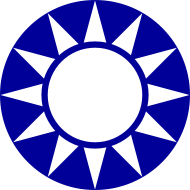
|
|
| Chairman | Wu Po-hsiung |
| Founded | 1919-10-10 (modern) 1894-11-24 (as Revive China Society) |
| Headquarters | 232-234 Bade Rd., Sec. 2 Zhongshan District, Taipei City, Taiwan, Republic of China |
| Official newspaper | Central Daily News |
| Membership (2006) | 1,089,000 |
| Official ideology/ political position |
Three Principles of the People, Conservatism, Anti-communism, Centre-right, Chinese nationalism, Chinese reunification. |
| International affiliation | International Democrat Union |
| Official color(s) | Blue |
| Website | www.kmt.org.tw |
The Kuomintang of China (abbreviation KMT), also often translated as the Chinese Nationalist Party, is a political party in the Republic of China (ROC), known as Taiwan, and is currently the largest political party in terms of seats in the Legislative Yuan ( 立法院), and the oldest political party, in the Republic of China. The KMT is a member of the International Democrat Union. Together with the People First Party ( 親民黨) and Chinese New Party ( 新黨), the KMT forms what is known as the Taiwanese Pan-Blue coalition ( 泛藍聯盟), which supports eventual reunification with the mainland. However, the KMT has been forced to moderate their stance by advocating political and legal status quo of modern Taiwan.
The KMT originated in China in 1912, founded by Song Jiaoren (宋教仁) and Sun Yat-sen (孫中山) shortly after the Xinhai Revolution (辛亥革命). After World War I, the Kuomintang set up a separate government in southern China and tried to obtain international recognition. In 1924 the party held its First National Congress, which included delegates from the Chinese Communist Party who exercised considerable influence. The power of the Communists in the Kuomintang increased sharply from 1924 until 1927, when Chiang Kai-shek ( 蔣介石) began a campaign to expel them and unify China under the Kuomintang. Led by Chiang Kai-shek ( 蔣介石), the KMT ruled much of China from 1928 until its retreat to Taiwan in 1949, after its defeat by the Communist Party of China (CPC). There, the KMT controlled the government under a single party state until reforms from the late 1970s through the 1990s loosened its grip on power. The ROC was once referred to synonymously with the KMT and known simply as "Nationalist China" after its ruling party.
History
Early years
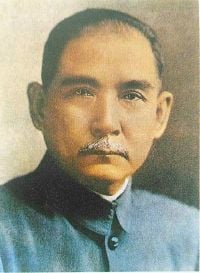
The Kuomintang was founded in Guangdong (广东省) Province on August 25, 1912 from a collection of several revolutionary groups that had successfully overthrown the Qing Dynasty in the Xinhai Revolution, including the Revolutionary Alliance, as a moderate democratic socialist party. The party traces its roots to the Revive China Society (興中會, Xingzhonghui), which was founded in Hawaii by Dr. Sun Yat-Sen in November, 1895, as a platform for revolutionary activities, and merged with several other anti-monarchist societies as the Revolutionary Alliance (Tongmenghui) in 1905.
Dr. Sun Yat-sen, who had just stepped down as provisional president of the Republic of China (中華民國總統), was chosen as its overall leader under the title of premier (總理), and Huang Xing (黃興) was chosen as Sun's deputy. However, the most influential member of the party was the third-ranking Song Jiaoren ( 宋教仁), who assured the Kuomintang’s success in the 1912 National Assembly election by mobilizing massive support from gentry and merchants, with a platform of promoting constitutional parliamentary democracy.

Though the party had an overwhelming majority in the first National Assembly, President Yuan Shikai (袁世凱) disregarded the Constitution and began ignoring the parliamentary body in making presidential decisions. On March 20, 1913, parliamentary leader Song Jiaoren died of wounds from an assassination attempt at a Shanghai rail station while on his way to deliver speeches supporting a cabinet system. Yuan Shikai was speculated to be the instigator of this plot. In July of 1913, members of the KMT led by Sun Yat-sen staged the Second Revolution, a poorly planned and ill-supported armed uprising to overthrow Yuan, and failed. In November, Yuan dissolved the KMT, whose members had largely fled into exile in Japan. Early in 1914, Yuan Shikai dismissed the parliament, and In December, 1915, he proclaimed himself emperor.
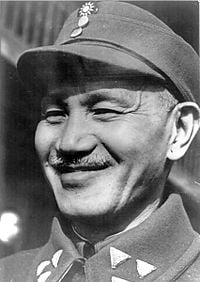
While exiled in Japan in 1914, Dr. Sun Yat-sen established the Chinese Revolutionary Party, but many of his old revolutionary comrades, including Huang Xing, Wang Jingwei, Hu Hanmin and Chen Jiongming, refused to join him or support his efforts in inciting armed uprising against Yuan Shikai. In order to join the Chinese Revolutionary Party, prospective members were required to take an oath of personal loyalty to Sun, which many old revolutionaries regarded as undemocratic and contrary to the spirit of the revolution. Sun was largely sidelined within the Republican movement during this period. IN 1916, Yuan Shikai died and China fell into the Warlord Period (1916 – 1928), when China was governed by whichever warlord controlled Beijing. In 1917, Sun returned to China to establish a rival government in Guangzhou (廣州), but was soon forced out of office and exiled to Shanghai. There, with renewed support, he resurrected the KMT on October 10, 1919, under the name Chinese Kuomintang.
After World War I, anger over Beijing’s concession of German-occupied territories to Japan sparked a major student uprising, the May Fourth Movement of 1919. In November of 1920, Sun and the KMT returned to Guangdong, where he was elected the president of the Republic of China by the extraordinary parliament there. However, the warlord of Guangzhou drove him out of the city.[1] In 1923, the KMT and its government accepted aid from the Soviet Union after being denied recognition by the western powers. Mikhail Borodin, a Soviet adviser was sent by the Comintern to aid in the reorganization and consolidation of the KMT along the lines of the Communist Party of the Soviet Union, establishing a Leninist party structure that lasted into the 1990s. The Chinese Communist Party (CCP) was under Comintern instructions to cooperate with the KMT, and its members were encouraged to join while maintaining their separate party identities, forming the First United Front between the two parties.
Soviet advisers also helped the Nationalists set up a political institute to train propagandists in mass mobilization techniques, and in 1923 Chiang Kai-shek, one of Sun's lieutenants from the Tongmenghui (同盟會) days, was sent to Moscow for several months' military and political study. At the first party congress in 1924 , which included non-KMT delegates such as members of the CCP, they adopted Sun's political platform, which included the Three Principles of the People ( 三民主義): nationalism, democracy, and people's livelihood.
In May, 1924, the KMT and the Chinese Communist Party established the Whampoa Military Academy near Guangzhou to train military officials to lead a Northern Expedition against the warlords.
War
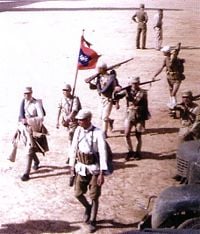
Following the death of Sun Yat-sen in 1925, General Chiang Kai-shek emerged as the KMT leader at the second National Congress in January, 1926. Three months later he took action against the Communists in Guangzhou and arrested many of the Soviet advisors. In May, 1926, the Central Executive Committee of the revolutionary government approved Chiang’s proposal to end Communist influence in the KMT.[1]
In June of 1926, Chiang launched the Northern Expedition to defeat the northern warlords and unite China under the party. By March of 1927, KMT forces had taken control of China as far north as Shanghai and Nanjing. The left-wing faction of the KMT, under Wang Jingwei (1883 – 1944) formed a government in Wuhan, and the right-wing factor under Chiang established a capital in Nanjing. The warlord government in Beijing continued to be internationally recognized as the official government of the Republic of China. In April of 1927, Chiang sent his forces into Shanghai to purge the Communists who had been allied with the KMT. Thousands were killed, others escaped and joined the Communist forces at the Soviet base in the Jinggang Mountains. On August 1, 1927, the Communists staged the Nanjing Uprising, initiating a civil war between the KMT and the CCP. The Central Committee of the KMT had not authorized Chiang’s purge of the Communists, and the Wuhan government removed him as commander-in-chief. Chiang responded by setting up his own government in Nanjing, but was forced to resign by KMT members and went into exile in Japan. The left-wing faction in Wuhan, fearing that the Soviets wanted to use the Chinese Communist Party to eliminate the KMT, began their own purge of Communists from the KMT. The left- and right-wing factions of the KMT reunited and set up the National Government of China in Nanjing.
In 1928 Chiang returned from Japan and resumed his post as commander-in-chief; the KMT took Beijing in June of 1928, symbolically re-uniting China.[1] On October 10, 1928, Chiang became the chairman of a new Chinese Nationalist government with its capital in Nanjing. Chiang continued to command the majority vote in the standing committee of the Central Executive Committee, the most powerful body in the KMT, until 1949. This period of KMT rule in China between 1927 and 1937 became known as the "Nanjing decade." In 1930-1931, an opposition government formed within the KMT, led by Wang Jingwei.
In 1930, Chiang launched the first of five annual campaigns against the Communists in south-central China. In 1932, the Japanese established the puppet state of Manchukuo and began to use it as a base to invade the rest of China. In 1934-1935, the Communist forces escaped to the northwest on their Long March to Yan’an in Shaanxi province. In December, 1936, KMT and CCP leaders kidnapped Chiang Kai Shek and forced him to agree to a united front against the Japanese. In 1937, the Japanese took Shanghai and Nanjing, and the Chinese began fighting the War of Resistance against Japan. Japanese advances forced Chiang to move his nationalist capital to Hankou and then to Chongqing in Sichuan. In 1938, the Japanese persuaded Wang Jingwei to desert the Nationalists and join them, on the grounds that resistance was suicidal and that he could do more to protect the Chinese people under a Japanese administration.
In September of 1939, World War II broke out and China had new allies, such as Great Britain. In December, 1941, after Japan bombed Pearl Harbor, the United States sent General Joseph Stillwell to serve as Chiang’s chief-of-staff. After Japan surrendered in August of 1945, American diplomats tried unsuccessfully to negotiate a KMT-CCP government for China, although the United States still supported the Nationalists and continued to offer them financial support.
On June 24, 1946, the Nationalists launched an offensive against Communist-held areas in Hubei and Henan. Chiang Kai-shek ordered his forces to defend the urbanized cities, giving the Communists a chance to move freely through the countryside. The Communists had recruited a broad base of support in China, particularly as military desertion, corruption and inflation were rampant in the KMT Nationalist government. By the end of 1947, the United States concluded that the Nationalists had no possibility of winning the civil war, and withdrew its support. In 1949, Communist forces took Beijing, Nanjing, Shanghai, Guangzhou and Chongqing. On October 1, 1949, Mao Zedong proclaimed the founding of the People’s Republic of China in Beijing. In the spring of 1949, Chiang had begun moving Nationalist troops to Taiwan Island. In December of 1949, he moved there, along with approximately two million Nationalists. There the KMT established a provisional government a provisional government which it called the Republic of China (ROC), claiming it to be the legitimate government of China.
Some party members stayed on the mainland and broke away from the main KMT to found the Revolutionary Committee of the Kuomintang, which currently exists as one of the eight minor registered parties in the People's Republic of China.
KMT in Taiwan
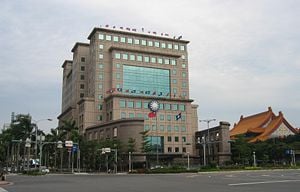
Following the establishment of the People's Republic of China (PRC) on October 1, 1949, the commanders of the PRC People's Liberation Army believed that Kinmen (金門) and Matsu (馬祖) had to be taken before a final assault on Taiwan. The KMT stopped the invasion at the Battle of Kuningtou (古寧頭之役). In 1950, Chiang took office in Taipei under the Temporary Provisions Effective During the Period of Communist Rebellion (動員戡亂時期臨時條款). The provision declared martial law in Taiwan and halted some democratic processes, including presidential and parliamentary elections, until the mainland could be recovered from the Communists. The KMT estimated that it would take three years to defeat the Communists. Their slogan was "prepare in the first year, start fighting in the second, and conquer in the third year." However, various factors, including international pressure, are believed to have prevented the KMT from a full-scale military engagement with the Communists. During the early years there was a cold war with some minor military conflicts.
The KMT-controlled government in Taipei actively claimed sovereignty over all China. The Republic of China in Taiwan retained China's seat in the United Nations until 1971.
Until the 1970s, KMT successfully pushed ahead with land reforms, developed the economy, implemented a democratic system in the lower levels of the government, improved cross-Taiwan Strait relations, and created the Taiwan “economic miracle.” However KMT controlled the government under a one-party authoritarian state until reforms enacted from the late 1970s through the 1990s. In the 1970s, the KMT began to allow for "supplemental elections" in Taiwan to fill the seats of the aging representatives in parliament. Although opposition parties were not permitted, Tangwai ((黨外or, "outside the party") representatives were tolerated. In the 1980s, the KMT focused on transforming the government from a single-party system to a multi-party democracy and embracing "Taiwanizing" (臺灣本土化運動).
The Democratic Progressive Party (民主進步黨.DPP) was founded in 1986 and began to compete against the KMT in Parliamentary elections. In 1991, martial law ceased when President Lee Teng-Hui (李登輝) terminated the Temporary Provisions Effective During the Period of Communist Rebellion. All parties were then allowed to compete in elections at every level, including the presidential election. Lee Teng-hui, the ROC's first democratically-elected President and the leader of the KMT during the 1990s, announced his advocacy of "special state-to-state relations" with the PRC, an announcement which the People’s Republic of China equated with an assertion of Taiwanese independence.
A split in the KMT in 1994, attributed to dissatisfaction with Lee's corrupted style of government, led to the formation of the Chinese New Party. Since the purging of Lee, the New Party has, largely reintegrated into the KMT. A much more serious split in the party occurred as a result of the 2000 Presidential election. Upset at the choice of Lien Chan (連戰) as the party's presidential nominee, former party Secretary-General James Soong ( 宋楚瑜) launched an independent bid, which resulted in the expulsion of Soong and his supporters and the formation of the People's First Party (PFP). The KMT candidate placed third behind Soong in the elections. After the election, Lee's strong relationship with the opponent became apparent. In order to prevent defections to the PFP, Lien moved the party away from Lee's pro-independence policies and became more favorable toward Chinese reunification. This shift led to Lee's expulsion from the KMT and the formation of the Taiwan Solidarity Union.
Support
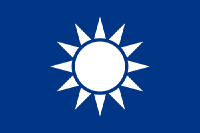
Support for the Kuomintang in the Republic of China encompasses a wide range of groups. Kuomintang support tends to be higher in northern Taiwan and in urban areas, where it draws its backing from owners of small to medium businesses and the self-employed, who make up the majority of commercial interests in Taiwan. Big business is also likely to support the KMT because of its policy of maintaining commercial links with mainland China. The KMT also has strong support in the labor sector because of the many labor benefits and insurance implemented while the KMT was in power. The KMT traditionally has strong cooperation with labor unions, teachers, and government workers. Among the ethnic groups in Taiwan, the KMT has solid support among mainlanders and their descendants for ideological reasons and among Taiwanese aboriginals.
Opponents of the KMT include strong supporters of Taiwan independence, people of Hoklo (Hokkien) background, and rural residents, though supporters of unification include Hoklo and supporters of independence include mainlanders. There is opposition to the KMT due to its image both as a mainlanders' and a Chinese nationalist party out of touch with local values. In addition, many oppose the KMT on the basis of its authoritarian past, large amount of party assets, alleged corruption, and patronage networks.
Current Issues and Challenges
Financial Mismanagement and Corruption
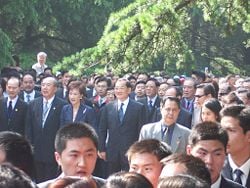
As the ruling party on Taiwan, the KMT amassed a vast business empire of banks, investment companies, petrochemical firms, and television and radio stations, thought to have made it the world's richest political party, with assets once estimated to be around US$ 2.0-10 billion [2]. Although this war chest appeared to contribute to the KMT’s political strength until the mid-1990s, accusations of corruption after 2000 made the KMT's financial holdings more of a liability than an asset. After 2000, the KMT started to divest itself of its assets, but the transactions were not publicly disclosed. During the 2004 presidential election there were accusations that the KMT had retained assets that were illegally acquired. A law has been proposed by the DPP in the Legislative Yuan to recover illegally acquired party assets and return them to the government; however, since the Pan-Blue alliance, the KMT and its smaller partner PFP, control the legislature, it is unlikely to pass. The KMT itself acknowledged that some of its assets were acquired through extra-legal means and promised to "retro-endow" them to the government. There is still a heated debate over which of the assets should be classified as “illegal.” DPP, the current ruling party, claims that the KMT has not acknowledged all of its assets, and that the recent sale of assets by the KMT in order to resolve its recent financial difficulties is illegal.
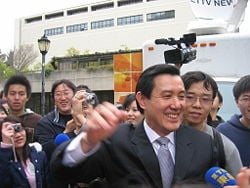
In 2005, then-party chairman Lien Chan announced that he was retiring from office. On July 16, 2005, Taipei Mayor Ma Ying-jeou was elected as KMT chairman in the first contested leadership in the Kuomintang's 93-year history. Some 54 percent of the party's 1.04 million members cast their ballots. Ma Ying-jeou garnered 72.4 percent of the votes against his opponent, Wang Jin-pyng's 27.6 percent. On February 13, 2007, Ma was indicted by the Taiwan High Prosecutors Office on charges of allegedly embezzling approximately NT$11 million (US$339,000), for "special expenses" while he was mayor of Taipei. Shortly after the indictment, he submitted his resignation as chairman of the Kuomintang.
Relations with People’s Republic of China
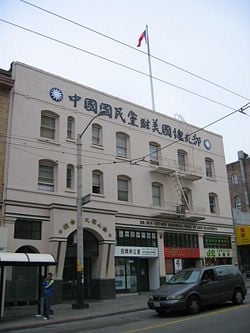
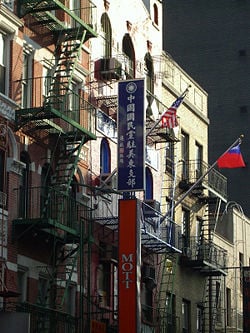
Relations between the Republic of China in Taiwan and the government of the People’s Republic of China remain delicate. In December 2003, then-KMT Chairman (present Chairman Emeritus) and presidential candidate, Lien Chan, initiated what appeared to some to be a major shift in the party's position on the linked questions of Chinese reunification and Taiwan independence. Speaking to foreign journalists, Lien said that while the KMT was opposed to "immediate independence," it did not wish to be classed as "pro-reunificationist" either.
At the same time, Wang Jin-pyng ( 王金平), speaker of the Legislative Yuan and the Pan-Blue Coalition's campaign manager in the 2004 presidential election, said that the party no longer opposed Taiwan's "eventual independence." This statement was later clarified as meaning that the KMT opposes any immediate decision on unification and independence and would like to have this issue resolved by future generations. The KMT's position on the cross-strait relationship was redefined as hoping to remain in the current “neither-independent-nor-united” situation.
There has been a recent warming of relations between the Pan-Blue Coalition and the PRC, with prominent members of both the KMT and PFP in active discussions with officials on the mainland. On March 28, 2005, 30 members of the Kuomintang (KMT), led by KMT vice chairman Chiang Pin-kung ( 江丙坤), arrived in mainland China, marking the first official visit by the KMT to the mainland since it was defeated by Communist forces in 1949 (although KMT members, including Chiang, had made individual visits in the past). The delegates began their itinerary by paying homage to the revolutionary martyrs of the Tenth Uprising at Huanghuagang. They subsequently flew to the former ROC capital of Nanjing to commemorate Sun Yat-sen. During the trip KMT signed a ten-point agreement with the CPC. Their opponents regarded this visit as the prelude to a third KMT-CPC cooperation. Weeks afterwards, in May, Chairman Lien Chan visited the mainland and met with Hu Jintao (胡錦濤). No agreements were signed because Chen Shui-bian (陳水扁)'s government threatened to prosecute the KMT delegation for treason and violation of R.O.C. laws prohibiting citizens from collaborating with Communists.
Notes
- ↑ 1.0 1.1 1.2 Dorothy Perkins, Encyclopedia of China: The Essential Reference to China, Its History and Culture (New York: Facts on File, 1999).
- ↑ Adela Lin and Samson Ellis, Once Worth Billions, Long-Ruling Taiwan Party Now Short of Cash Bloomberg, September 27, 2017. Retrieved June 15, 2018.
References
ISBN links support NWE through referral fees
- Hood, Steven J. The Kuomintang and the democratization of Taiwan. Boulder, CO: Westview Press, 1997. ISBN 0813390079
- Marks, Thomas A. Counterrevolution in China Wang Sheng and the Kuomintang. London: Frank Cass, 1996. ISBN 0714647004
- Perkins, Dorothy. Encyclopedia of China: The Essential Reference to China, Its History and Culture. New York: Facts on File, 1999. ISBN 0816026939
- Roy, Denny. Taiwan a political history. Ithaca: Cornell University Press, 2003. ISBN 080144070X
- Schiffrin, Harold Z. Sun Yat-sen, reluctant revolutionary. Boston: Little, Brown, 1980. ISBN 0316773395
- Tien, Hung-mao. Government and politics in Kuomintang China, 1927-1937. Stanford: Stanford University Press, 1972. ISBN 0804708126
- Wills, John E. Mountain of fame portraits in Chinese history. Princeton, NJ: Princeton University Press, 1994. ISBN 0691055424
External links
All links retrieved June 15, 2018.
- Kuomintang Official Website.
| Main events (1916-1920) | Main events (1920-1930) | Northern Factions | Southern Factions |
|---|---|---|---|
|
|
Beiyang Army:
Regional:
|
|
| Main events pre-1945 | Main events post-1945 | Specific articles |
|---|---|---|
|
Part of the Cold War
|
Primary participants
|
Credits
New World Encyclopedia writers and editors rewrote and completed the Wikipedia article in accordance with New World Encyclopedia standards. This article abides by terms of the Creative Commons CC-by-sa 3.0 License (CC-by-sa), which may be used and disseminated with proper attribution. Credit is due under the terms of this license that can reference both the New World Encyclopedia contributors and the selfless volunteer contributors of the Wikimedia Foundation. To cite this article click here for a list of acceptable citing formats.The history of earlier contributions by wikipedians is accessible to researchers here:
- Kuomintang history
- Song_Jiaoren history
- Revive_China_Society history
The history of this article since it was imported to New World Encyclopedia:
- History of "Kuomintang"
Note: Some restrictions may apply to use of individual images which are separately licensed.
↧ Download as ZWI file | Last modified: 02/04/2023 03:50:57 | 21 views
☰ Source: https://www.newworldencyclopedia.org/entry/Kuomintang | License: CC BY-SA 3.0
 ZWI signed:
ZWI signed: KSF
KSF